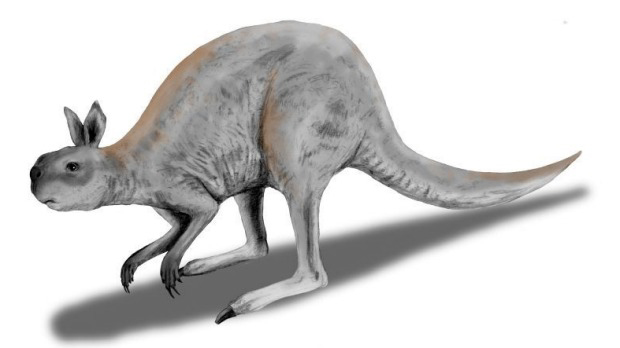


An online article by Amy Mitchell-Whittington on the BrisbaneTimes - Australia's megafauna wiped out by humans, research finds - reports that Australia's megafauna became extinct due to humans rather than climate change.

The giant kangaroo Procoptodon. Image: Nobu Tomura
A team of 16 scientists has analysed a broad range of data and found human predation was the likely factor behind the extinction of Australia's megafauna, including the wombat-like diprotodon, the flightless bird genyronis and the giant kangaroo procoptodon. The finding comes in direct contrast to the existing theory that found megafauna extinction was most likely due to climate change and not the introduction of humans to the continent.
James Cook University professor Michael Bird said the team's multidisciplinary effort, which included ecologists, archeologists, geologists, paleontologists and climate scientists, ensured quality control on every piece of available data studied. The physical evidence was matched with known climate records from the period and the history of human movement into the continent.
Data analysis determined when megafauna went extinct, which Professor Baird said was found to have been between 45,000 to 50,000 years ago, and whether that overlapped with a climate shift and/or human arrival on the Sahul landmass, an 'unbroken' continent that is now New Guinea, the Australian mainland and Tasmania.
Professor Baird stated that the change in climate occurred from 30,000 to 20,000 years ago and was unlikely to have been the main factor behind the extinction of megafauna, given the very short geological period and the varied climate across the landmass. Megafauna had lived through several previous ice ages without any problems, and there is nothing exceptional about the last cycle compared to previous cycles over the last 2 million years. Climate may have a small impact, but the evidence points strongly to human impact as the cause of extinction - as a gradual process - for these megafauna over the period of thousands of years.
Human predation was likely to be the primary driver behind extinction. It appears to be a human trait - humans tend to exploit the environments when they arrive to the extent that they can.
Yuval Noah Harari agrees. In his publication Sapiens - A Brief History of Humankind he writes about the human colonization of Australia:
'Up until then humans had displayed some innovative adaptations and behaviours, but their effect on their environment had been negligible. They had demonstrated remarkable success in moving into and adjusting to various habitats, but they did so without drastically changing those habitats. The settlers of Australia, or more accurately, its conquerors, didn't just adapt, they transformed the Australian ecosystem beyond recognition.
'The first human footprint on a sandy Australian beach was immediately washed away by the waves. Yet when the invaders advanced inland, they left behind a different footprint, one that would never be expunged. As they pushed on, they encountered a strange universe known creatures that included a 200-kilogram, two-metre kangaroo, and a marsupial lion, as massive as a modern tiger, that was the continent's largest predator. Koalas far too big to be cuddly andcute rustled in the trees and flightless birds twice the size of ostriches sprinted on the plains. Dragon-like lizards and snakes five metres long slithered through the undergrowth. The giant diprotodon, a two-and-a-half-ton wombat, roamed the forests. Except for the birds and reptiles, all these animals were marsupials like kangaroos, they gave birth to tiny, helpless, fetus-like young which they then nurtured with milk in abdominal pouches. Marsupial mammals were almost unknown in Africa and Asia, but in Australia they reigned supreme.
'Within a few thousand years, virtually all of these giants vanished. Of the twenty-four Australian animal species weighing fifty kilograms or more, twenty three became extinct. A large number of smaller species also disappeared. Food chains throughout the entire Australian ecosystem were broken and rearranged. It was the most important transformation of the Australian ecosystem for millions of years.
The first colonization of Australia is shown on the Journey of Mankind Genetic Map:
http://www.bradshawfoundation.com/stephenoppenheimer/index.php
You may purchase Sapiens via our Book Review section:
http://www.bradshawfoundation.com/books/sapiens_a_brief_history_of_humankind.php
Comment
by Bradshaw Foundation
Tuesday 21 March 2023
by Bradshaw Foundation
Tuesday 07 February 2023
by Bradshaw Foundation
Thursday 19 May 2022
by Bradshaw Foundation
Tuesday 19 October 2021
by Bradshaw Foundation
Friday 25 June 2021
by Bradshaw Foundation
Monday 09 November 2020
by Bradshaw Foundation
Tuesday 03 November 2020
by Bradshaw Foundation
Wednesday 28 October 2020
by Bradshaw Foundation
Tuesday 23 June 2020
by Bradshaw Foundation
Thursday 04 June 2020
by Bradshaw Foundation
Thursday 14 May 2020
by Bradshaw Foundation
Tuesday 12 May 2020
by Bradshaw Foundation
Wednesday 19 February 2020
by Bradshaw Foundation
Tuesday 21 January 2020
by Bradshaw Foundation
Monday 20 January 2020
by Bradshaw Foundation
Thursday 28 November 2019
by Bradshaw Foundation
Tuesday 21 March 2023
by Bradshaw Foundation
Tuesday 07 February 2023
by Bradshaw Foundation
Thursday 19 May 2022
by Bradshaw Foundation
Tuesday 19 October 2021
by Bradshaw Foundation
Friday 25 June 2021
by Bradshaw Foundation
Monday 09 November 2020
by Bradshaw Foundation
Tuesday 03 November 2020
by Bradshaw Foundation
Wednesday 28 October 2020
by Bradshaw Foundation
Tuesday 23 June 2020
by Bradshaw Foundation
Thursday 04 June 2020
by Bradshaw Foundation
Thursday 14 May 2020
by Bradshaw Foundation
Tuesday 12 May 2020
by Bradshaw Foundation
Wednesday 19 February 2020
by Bradshaw Foundation
Tuesday 21 January 2020
by Bradshaw Foundation
Monday 20 January 2020
by Bradshaw Foundation
Thursday 28 November 2019
Friend of the Foundation











